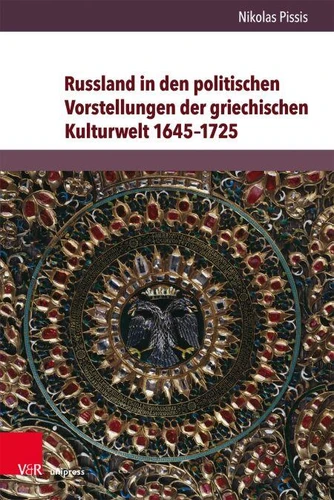Russland in den politischen Vorstellungen der griechischen Kulturwelt 1645–1725
Par :Formats :
Disponible dans votre compte client Decitre ou Furet du Nord dès validation de votre commande. Le format PDF est :
- Compatible avec une lecture sur My Vivlio (smartphone, tablette, ordinateur)
- Compatible avec une lecture sur liseuses Vivlio
- Pour les liseuses autres que Vivlio, vous devez utiliser le logiciel Adobe Digital Edition. Non compatible avec la lecture sur les liseuses Kindle, Remarkable et Sony
 , qui est-ce ?
, qui est-ce ?Notre partenaire de plateforme de lecture numérique où vous retrouverez l'ensemble de vos ebooks gratuitement
Pour en savoir plus sur nos ebooks, consultez notre aide en ligne ici
- Nombre de pages502
- FormatPDF
- ISBN978-3-8470-0873-6
- EAN9783847008736
- Date de parution16/11/2020
- Protection num.pas de protection
- Taille5 Mo
- Infos supplémentairespdf
- ÉditeurV&R Unipress
Résumé
Russland als orthodoxe Führungsmacht, der Zar als designierter Erbe der oströmischen Kaiser, Schutzherr und messianischer Erlöser der »gefangenen« Ostkirche aus der osmanischen Herrschaft - diese Vorstellungen gerieten seit dem 17. Jahrhundert zu Topoi, die das Selbstverständnis der russischen Monarchie sowie die Wahrnehmungen der europäischen Diplomatie und der Hohen Pforte mitprägten. Der Autor untersucht die Genese dieses Vorstellungskomplexes in griechischen kirchlichen Gelehrtenkreisen, seine Verbreitung und seinen Wandel unter Berücksichtigung und Rekonstruktion der wechselnden Kontexte.
Fern davon, eine spezifisch osteuropäische Entwicklung oder eine zeitlose byzantinische Tradition darzustellen, gehören die untersuchten Phänomene zum gemeinsamen Fundus der europäischen Frühen Neuzeit. Russia represents the leading Orthodox power, the Tsar takes the place of the designated heir to the Eastern Roman emperors, patron and messiah of the "captured" Eastern Church from Ottoman rule.
Since the 17th century these ideas were topoi, and shaped not only the conception of the Russian monarchy but also the perceptions of the European diplomacy and the Sublime Porte. The author examines the genesis of this conception in Greek ecclesiastical scholar circles, its distribution and its transition. Here, he considers and reconstructs the changing contexts. The aim of the work is not to depict a specifically Eastern European development or a timeless Byzantine tradition, respectively, since the phenomena examined belong to the common fund of the European early modern period.
Fern davon, eine spezifisch osteuropäische Entwicklung oder eine zeitlose byzantinische Tradition darzustellen, gehören die untersuchten Phänomene zum gemeinsamen Fundus der europäischen Frühen Neuzeit. Russia represents the leading Orthodox power, the Tsar takes the place of the designated heir to the Eastern Roman emperors, patron and messiah of the "captured" Eastern Church from Ottoman rule.
Since the 17th century these ideas were topoi, and shaped not only the conception of the Russian monarchy but also the perceptions of the European diplomacy and the Sublime Porte. The author examines the genesis of this conception in Greek ecclesiastical scholar circles, its distribution and its transition. Here, he considers and reconstructs the changing contexts. The aim of the work is not to depict a specifically Eastern European development or a timeless Byzantine tradition, respectively, since the phenomena examined belong to the common fund of the European early modern period.
Russland als orthodoxe Führungsmacht, der Zar als designierter Erbe der oströmischen Kaiser, Schutzherr und messianischer Erlöser der »gefangenen« Ostkirche aus der osmanischen Herrschaft - diese Vorstellungen gerieten seit dem 17. Jahrhundert zu Topoi, die das Selbstverständnis der russischen Monarchie sowie die Wahrnehmungen der europäischen Diplomatie und der Hohen Pforte mitprägten. Der Autor untersucht die Genese dieses Vorstellungskomplexes in griechischen kirchlichen Gelehrtenkreisen, seine Verbreitung und seinen Wandel unter Berücksichtigung und Rekonstruktion der wechselnden Kontexte.
Fern davon, eine spezifisch osteuropäische Entwicklung oder eine zeitlose byzantinische Tradition darzustellen, gehören die untersuchten Phänomene zum gemeinsamen Fundus der europäischen Frühen Neuzeit. Russia represents the leading Orthodox power, the Tsar takes the place of the designated heir to the Eastern Roman emperors, patron and messiah of the "captured" Eastern Church from Ottoman rule.
Since the 17th century these ideas were topoi, and shaped not only the conception of the Russian monarchy but also the perceptions of the European diplomacy and the Sublime Porte. The author examines the genesis of this conception in Greek ecclesiastical scholar circles, its distribution and its transition. Here, he considers and reconstructs the changing contexts. The aim of the work is not to depict a specifically Eastern European development or a timeless Byzantine tradition, respectively, since the phenomena examined belong to the common fund of the European early modern period.
Fern davon, eine spezifisch osteuropäische Entwicklung oder eine zeitlose byzantinische Tradition darzustellen, gehören die untersuchten Phänomene zum gemeinsamen Fundus der europäischen Frühen Neuzeit. Russia represents the leading Orthodox power, the Tsar takes the place of the designated heir to the Eastern Roman emperors, patron and messiah of the "captured" Eastern Church from Ottoman rule.
Since the 17th century these ideas were topoi, and shaped not only the conception of the Russian monarchy but also the perceptions of the European diplomacy and the Sublime Porte. The author examines the genesis of this conception in Greek ecclesiastical scholar circles, its distribution and its transition. Here, he considers and reconstructs the changing contexts. The aim of the work is not to depict a specifically Eastern European development or a timeless Byzantine tradition, respectively, since the phenomena examined belong to the common fund of the European early modern period.




